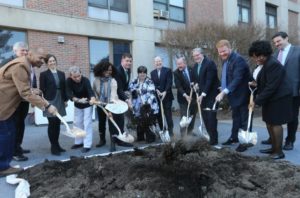
Officials, including Boston Mayor Marty Walsh, center, celebrate groundbreaking on an affordable housing project in Jamaica Plain in March 2019. Photo courtesy of the city of Boston.
Although Massachusetts compares favorably to other states, a new report indicates the commonwealth still has a shortage of affordable housing to meet the needs of its lowest-income residents.
Massachusetts had a higher rate of affordable housing availability compared to the national average in an analysis released Thursday by the National Low Income Housing Coalition. But Massachusetts still has about 170,000 too few rental units for the lowest-income households, a broader trend present in every state.
“This shows what is the case in most of the country: there’s just not enough housing for our extremely low-income households, for households that might be the most vulnerable to becoming homeless,” said Eric Shupin, director of public policy for the Citizens’ Housing and Planning Association in Boston. “We need to create more housing opportunity.”
The NLIHC produces a similar report tracking housing availability every year, focusing closely on “extremely low-income” households, which have a collective income either at the poverty level or at 30 percent of the area’s median income.
The latest analysis, using 2017 data, found that there were 46 affordable and available units in Massachusetts per 100 extremely low-income households. The national average was 37 units per 100 households, and more than a dozen states had even lower rates than that.
The Boston metropolitan area compared similarly to Massachusetts as a whole: better numbers than other areas, but still with a rate of 46 available and affordable units of housing per 100 households at the lowest income level. About 119,000 affordable units of the state’s 170,000-unit deficit are in the Boston area.
Experts said Massachusetts’ better-than-average numbers are likely a result of state programs, such as the rental voucher program and the $1.8 billion housing bond bill passed last session, that help expand access to affordable housing. Clark Ziegler, executive director of the Massachusetts Housing Partnership – a nonprofit that works with the state to improve housing production – said the report offered a “nuanced story.”
“The numbers are still daunting in terms of how much housing we still need for folks at those income levels, but the fact that we have done better than other metro areas really tells a story,” Ziegler said. “Work that’s gone back over decades here has not solved the problem, and we have a long way to go, but relative to other parts of the country, we are doing a better job.”
In Massachusetts, only 30 percent of extremely low-income renters are in the workforce. About a quarter are disabled, while another third are senior citizens. Almost 60 percent of the lowest-income households are severely cost-burdened, meaning they pay half their income or more on rent. Last week, advocates warned that 160,000 residents are on waiting lists to get into public housing.
Housing leaders say additional investment and action from the state is needed to improve conditions in Massachusetts. The Citizens’ Housing and Planning Association plans to request an increase int the appropriation for the state’s rental-voucher program – a program they said is key to the state’s better-than-average rates – from $100 million to $130 million in the fiscal year 2020 budget.
Lawmakers are also set to consider a housing bill Gov. Charlie Baker has made a central priority. The legislation would change the requirement for zoning changes from a two-thirds majority of municipal boards to a simple majority. Baker argues the change will help accelerate housing production, but critics of his approach say it won’t ensure enough affordable housing.






